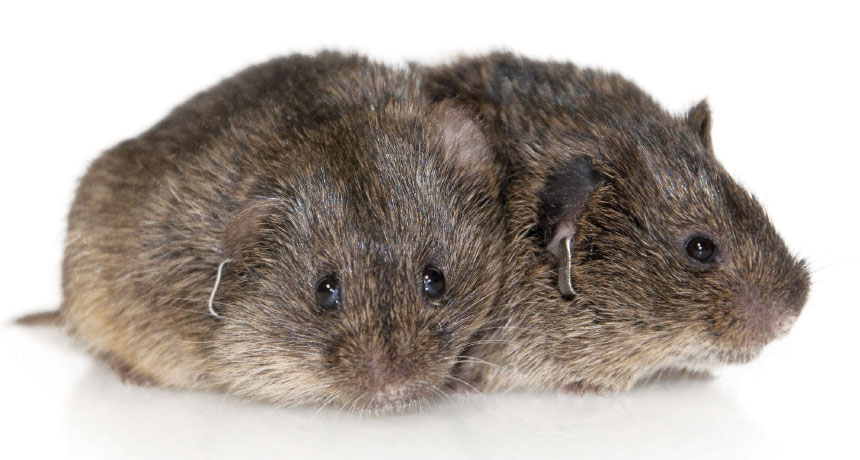What really changes when a male vole settles down
Bachelors can’t tell one female from another

PAIR-BOND Just 24 hours in each other's company without mating can be enough to bond a pair of prairie voles for life.
Aubrey Kelly
Bachelor prairie voles can’t tell females of their species apart. Yet the clueless fellows can change, forming pair-bonds for life with the opposite sex and even distinguishing between two female strangers.
Bachelors aren’t blind or stupid; they recognize individual males among their fellow short-tailed Microtus ochrogaster rodents scurrying through old fields in the center of North America.
And males are certainly interested in the interchangeable females. In lab tests, bachelors claw and bite at cage dividers between the sexes, says Alexander Ophir of Cornell University.
Conquering the divide and mating with a female after just six hours of her company can form a lifelong pair-bond between voles. Only about 5 percent of mammal species live this socially monogamous lifestyle, and the voles have played starring roles in studies of the neurobiology of bonding. (Social monogamists, including both voles and some Homo sapiens, don’t entirely forgo extra-pair encounters.)
A pair-bonded couple can crowd three litters of young into their roughly six to nine months of life in the wild, Ophir says. One aid to speeding through family life: Females can get pregnant as soon as they give birth. “You sometimes see pups being delivered as males are trying to copulate with the female,” he says.
Pair-bonding requires recognizing at least one female. “It’s all well and good to fall in love, but if you don’t know who you fell in love with, it’s worthless,” Ophir says. And paired-up voles can go further. Tests show they notice the difference between two females they have never mated with, Ophir and former student Tomica Blocker report in the October Animal Behaviour.
To test recognition powers, Blocker staged repeated appearances of an unfamiliar female beside a male’s cage. As the encounters progressed, a pair-bonded male tended to spend less and less time sniffing her scent — unless Blocker substituted a new and unfamiliar visitor. Then the bonded male reverted to a prolonged investigation. Single males, however, just greeted the stand-in with cursory sniffs as if she were an alluring but already familiar visitor.
Acquiring the gift of distinguishing females only after bachelorhood may have advantages, Ophir muses. For instance, to find a mate in a short life, maybe any willing female is good. And persisting in the effort could be easier if a male can’t tell which lovely vole already rejected him.





